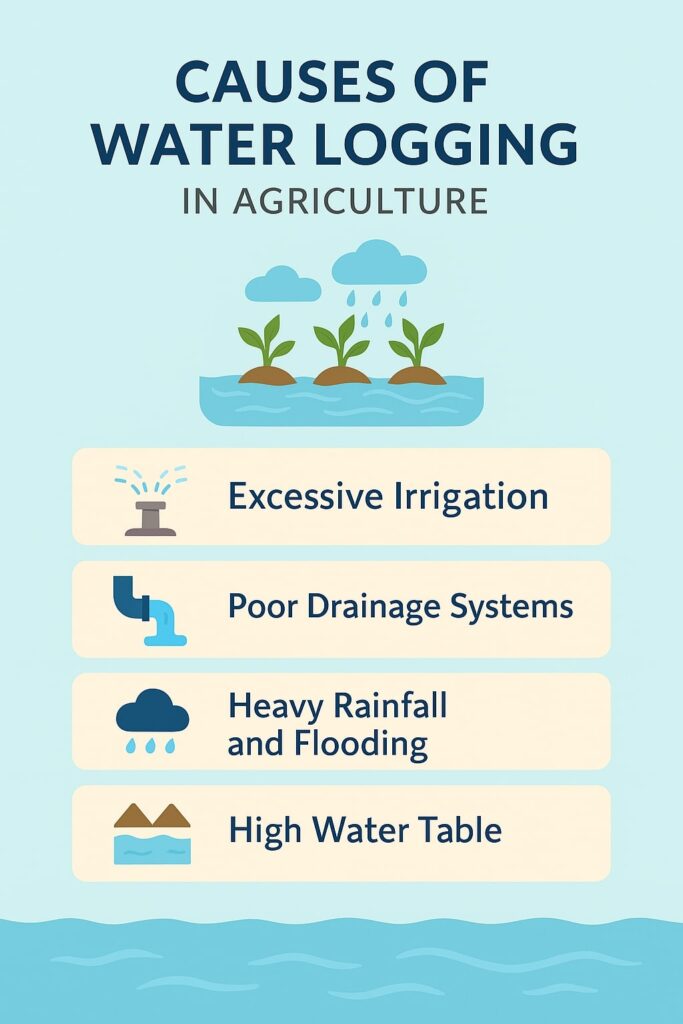In the realm of agriculture, where soil health and water availability are fundamental to crop productivity, water logging presents a persistent and often underestimated challenge. This phenomenon, characterized by the saturation of soil with excess water, not only disrupts plant growth but also severely affects soil structure, nutrient balance, and water quality.
In this article, we’ll explore what water logging is, its causes, and how it deteriorates both soil and water quality, ultimately threatening sustainable farming practices.
🚱 What is Water Logging?
WL occurs when the soil profile becomes saturated with water, leaving little to no air pockets for oxygen. This can happen due to excessive rainfall, poor drainage systems, over-irrigation, or high water tables. In such conditions, the roots of plants are deprived of oxygen, leading to reduced crop growth and, in many cases, crop failure.
🌧️ Common Causes of Water Logging in Agriculture
Understanding the causes of water logging is essential to mitigate its effects. Some of the primary reasons include:
- Excessive Irrigation
Overwatering, especially in flood irrigation systems, often exceeds the water-holding capacity of the soil, leading to saturation. - Poor Drainage Systems
Lack of proper surface or sub-surface drainage fails to remove excess water from fields, resulting in stagnant water. - Heavy Rainfall and Flooding
In regions with intense rainfall or seasonal flooding, water logging is a frequent issue, especially in low-lying agricultural lands. - High Water Table
In areas with naturally high groundwater levels, the soil remains waterlogged even without irrigation or rain. - Soil Type
Clayey soils with poor permeability retain water for longer periods, increasing the risk of water logging.
🌱 Impact of Water Logging on Soil Quality
Soil is a living ecosystem. When it’s waterlogged, its physical, chemical, and biological properties are altered, often for the worse. Here’s how water logging deteriorates soil quality:
1. Loss of Soil Aeration
Healthy soil contains 25-30% air. When water displaces air in the soil pores, aerobic microorganisms die off, and anaerobic conditions begin to dominate. This affects soil respiration and nutrient cycling.
2. Reduction in Soil Fertility
WL leads to the loss of essential nutrients such as nitrogen, phosphorus, and potassium through leaching, denitrification, and volatilization. This reduces soil fertility and the availability of nutrients to plants.
3. Soil Structure Degradation
Long-term saturation causes soil particles to disperse, leading to compaction and poor soil structure. This further reduces permeability and aeration.
4. Increase in Soil Salinity
In some regions, water logging is associated with salinity build-up, particularly when the groundwater is saline. Evaporation from stagnant water leaves salts behind, degrading soil health.
💧 Impact of Water Logging on Water Quality
WL doesn’t only affect the land—it also poses a risk to nearby water bodies:
1. Nutrient Runoff
Excess water often carries fertilizers and pesticides from the fields into nearby rivers, lakes, and groundwater, leading to eutrophication and pollution.
2. Contaminated Groundwater
In regions where water logging is frequent, the infiltration of polluted surface water into groundwater sources is common, reducing the quality of drinking and irrigation water.
3. Microbial Contamination
Anaerobic conditions in waterlogged soil favor harmful microbial activity, which can lead to contamination of water sources with pathogens.
Check Environment Category
🌾 Agricultural Consequences of Water Logging
From the farmer’s perspective, water logging has direct economic and environmental consequences:
- Reduced Crop Yields: Most crops cannot survive prolonged waterlogged conditions. Stunted growth, yellowing leaves, and root rot are common symptoms.
- Crop Failure: In severe cases, entire fields may be lost, especially for sensitive crops like wheat, cotton, and vegetables.
- Increased Pest and Disease Incidence: Stagnant water creates a breeding ground for pests and increases the prevalence of fungal diseases.
- Delayed Farming Operations: Saturated soils hinder tilling, planting, and harvesting, affecting overall farm productivity.
🛠️ Solutions to Manage and Prevent Water Logging
Fortunately, there are several strategies farmers can adopt to reduce the impact of water logging:
✅ 1. Improved Drainage Systems
Installing surface drains, open ditches, or subsurface tile drainage systems helps remove excess water efficiently.
✅ 2. Controlled Irrigation
Adopting modern irrigation methods such as drip or sprinkler irrigation reduces water usage and minimizes saturation.
✅ 3. Raised Bed Planting
Planting crops on raised beds allows water to drain away from root zones, reducing waterlogging risks.
✅ 4. Crop Selection
Growing water-tolerant crops like rice in flood-prone areas can be a practical solution.
✅ 5. Agroforestry and Cover Crops
Planting deep-rooted trees and cover crops can help improve soil structure and absorb excess water.
🌍 Water Logging and the Need for Sustainable Farming
As climate change continues to bring unpredictable rainfall patterns and rising groundwater levels, WL is expected to become more prevalent. Sustainable farming practices, including water management, soil conservation, and climate-resilient cropping systems, are essential to combat the adverse effects of water logging.
Farmers, policymakers, and agricultural researchers must work together to promote awareness, training, and support mechanisms that address water logging at both local and regional levels.
📌 Final Thoughts
Water logging is more than just a temporary inconvenience—it’s a major environmental and agricultural concern that directly impacts soil health, water quality, and food security. By recognizing the signs early and implementing appropriate preventive measures, farmers can protect their lands and ensure a more sustainable future for agriculture.
Learn more on United nation Food and Agricultural

